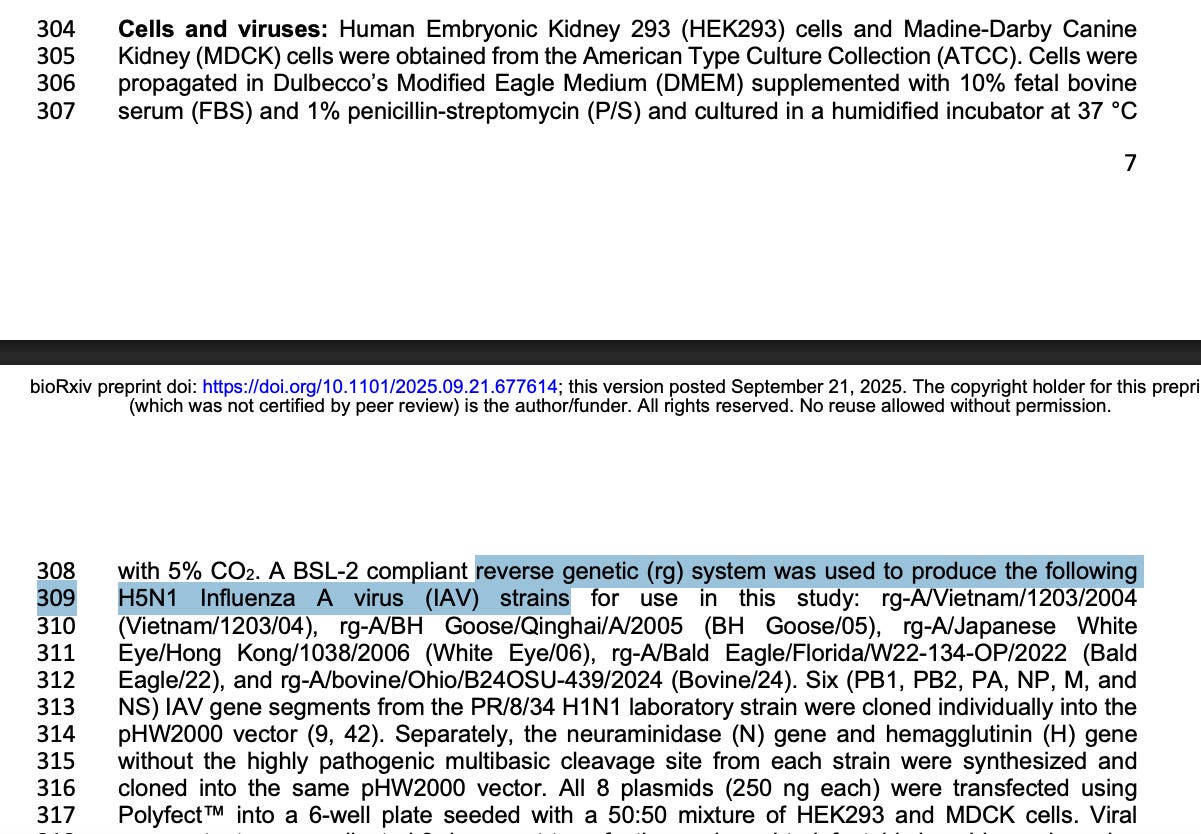This post was published by Jon Fleetwood. Please visit his Substack and subscribe to support his work. Follow Jon: Instagram@realjonfleetwood / X@JonMFleetwood / Facebook@realjonfleetwood
The U.S. Department of Agriculture (USDA) and the National Institutes of Health (NIH)—specifically its National Institute of Allergy and Infectious Diseases (NIAID)—have funded scientists at the University of Nebraska–Lincoln to create brand-new, never-before-seen influenza viruses through laboratory engineering, according to a September 21 preprint posted on bioRxiv.
The authors claim their aim was vaccine development, but the methods reveal the deliberate construction of novel pathogens with enhanced laboratory growth traits.
The COVID-19 pandemic was the result of lab-engineered pathogen creation, according to Congress, the White House, the Department of Energy, the FBI, and the CIA.
The revelation of this federally funded creation of novel pathogens on American soil comes just days after President Donald Trump stood before the United Nations calling for (here) a global end to bioweapons research, raising profound questions about whether “vaccine development” is now serving as the cover for the very gain-of-function experiments he condemned.
Stated Aim: A New Vaccine for Cattle
The paper frames its purpose around the 2024 detection of H5N1 bird flu in U.S. dairy herds and the lack of licensed cattle vaccines.
The authors present their work as an effort to design a “centralized consensus H5 vaccine” delivered with adenovirus vectors, hoping to elicit both systemic and mucosal immunity in calves.
They argue that such a vaccine would reduce agricultural losses and “remove cattle as a newly established reservoir for zoonotic spread” of bird flu.
Yet beneath the stated goal of protecting cattle lies the undeniable reality that U.S. tax dollars are being used to build entirely new influenza strains in the lab—dangerous, pandemic-causing pathogens created under the banner of “vaccine development.”
What They Actually Did: Built New Viruses That Never Existed in Nature
Instead of working with purpordedly circulating H5N1 isolates, the team engineered new pathogens using reverse genetics:
- Six internal gene segments (PB1, PB2, PA, NP, M, and NS) were pulled from the PR8 H1N1 laboratory strain, which is optimized for high replication in mammalian cells and chicken eggs.
- These were combined with synthetic H5 and N genes stripped of their natural multibasic cleavage site.
- The result: novel reassortant influenza viruses with enhanced lab replication efficiency compared to wild-type H5N1.
The viruses were generated in HEK293 and MDCK cells, then amplified in embryonated chicken eggs, all under BSL-2 laboratory conditions at the University of Nebraska–Lincoln.

Enhanced Growth and Replication Traits
By design, the engineered viruses gained new functions not seen in nature:
- Enhanced growth efficiency in eggs and mammalian cells from the PR8 backbone.
- Streamlined replication for lab handling.
- BSL-2 compatibility, expanding the number of facilities able to handle them.
Who Did the Work
- Joshua Wiggins
- Adthakorn Madapong
- Eric A. Weaver (corresponding author).
All three are affiliated with the Nebraska Center for Virology and the School of Biological Sciences at the University of Nebraska–Lincoln.
Where It Was Done
- Genetic engineering, reverse genetics virus creation, and animal studies were all performed at the University of Nebraska–Lincoln, under IBC and IACUC approvals.
- Work was conducted in BSL-2+ labs, required only for moderate-risk agents, despite the fact that the study involved the creation of novel influenza viruses capable of causing pandemics.
Who Paid for It
- USDA National Institute of Food and Agriculture (NIFA), Agriculture and Food Research Initiative (Grant Nos. 2020-06448, 2024-08723).
- NIH – NIAID (Grant No. 1R01AI147109).

Bombshell Details
- Replication-Competent Vectors: The study used replication-competent adenovirus vaccine platforms (Ad28 and Ad48) that can spread within the host, unlike safer replication-deficient types.
- Failed Protection Against the Actual Threat: Despite claims of vaccine promise, the engineered vaccine produced no protective neutralization against the circulating bovine H5N1 strain (Bovine/24)—the virus causing real outbreaks in U.S. cattle.
- No Cattle Challenge Studies: The vaccine was never tested against live infection in cattle, only in mice.
- Sex Bias: Only male calves were tested, ignoring potential sex differences in immune response. By testing only male calves, the study ignored well-established sex differences in immunity—females typically mount stronger antibody and T-cell responses but also suffer higher rates of adverse reactions—leaving half the population unaccounted for and casting doubt on the safety and applicability of the findings.
Bottom Line
While the University of Nebraska team presented their work as vaccine development, the methods show they constructed brand-new bird flu viruses through reverse genetics, engineered with a PR8 laboratory backbone to enhance replication traits.
These pathogens, created with federal funding, were built and amplified under BSL-2 conditions—labs designed for moderate-risk microbes, not novel influenza strains with pandemic potential.
The authors claim their goal was to stop the spread of H5N1 in cattle, but the vaccine failed to neutralize the very strain now circulating in U.S. herds, was never tested in cattle challenges, and excluded females altogether.
Coming just days after President Trump’s UN call to end bioweapons creation, this project exemplifies the dangerous reality that pandemic-capable pathogens are being created under the guise of “vaccine development.”
On American soil.
With American tax dollars.
Sound familiar?
Your support is crucial in helping us defeat mass censorship. Please consider donating via Locals or check out our unique merch. Follow us on X @ModernityNews.
More news on our radar





















Gain of function is illegal. Whoever sought to do this should be charged.
UNL-The Josef Mengele school of Biology.
What could go wrong?